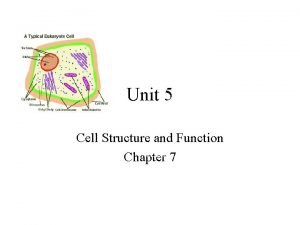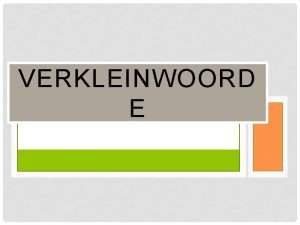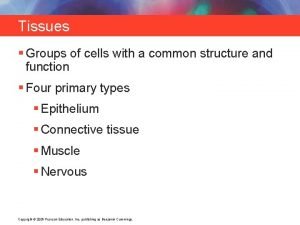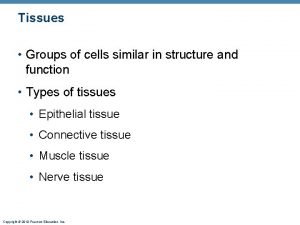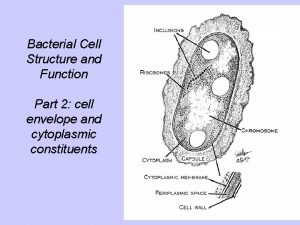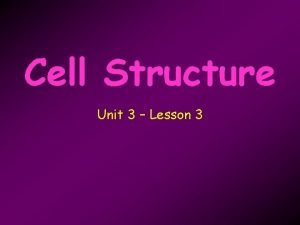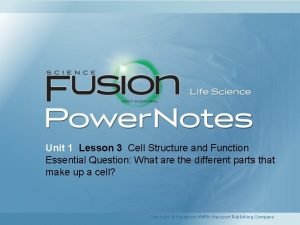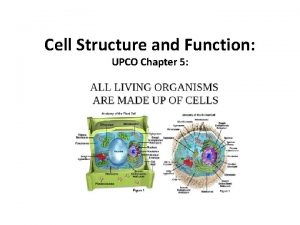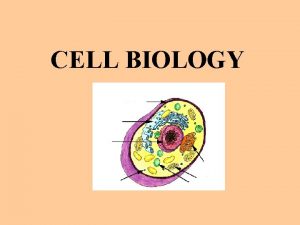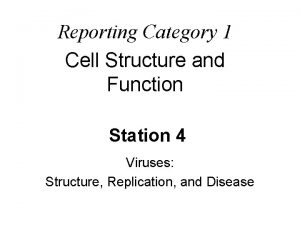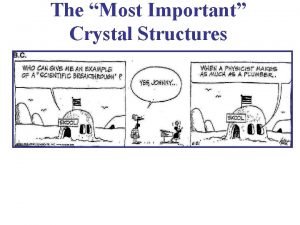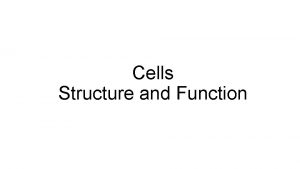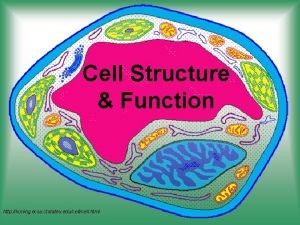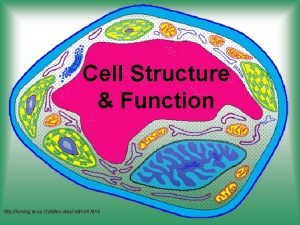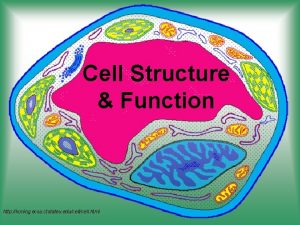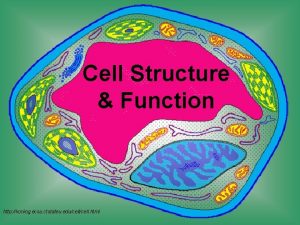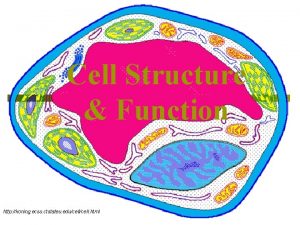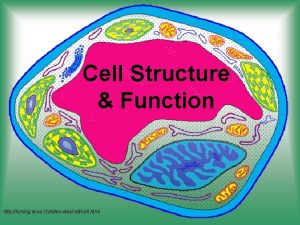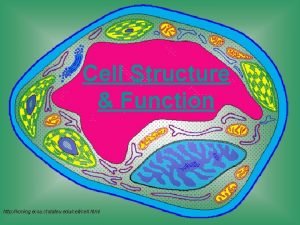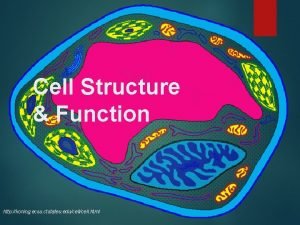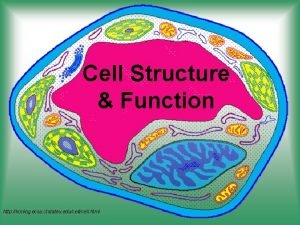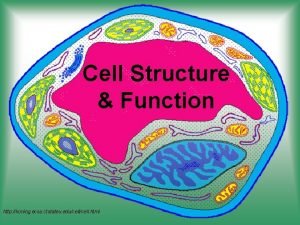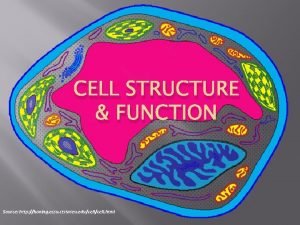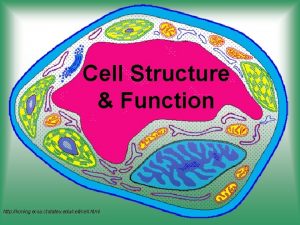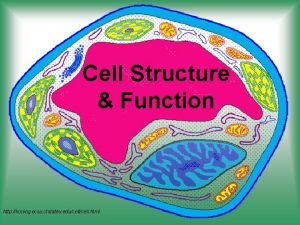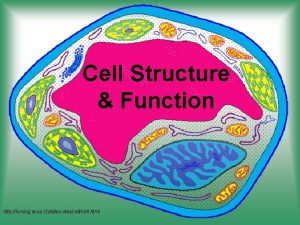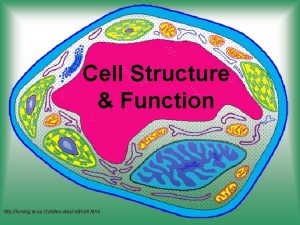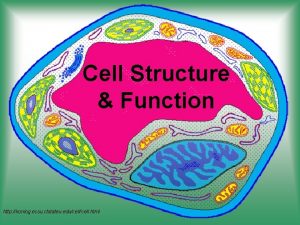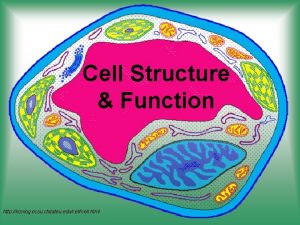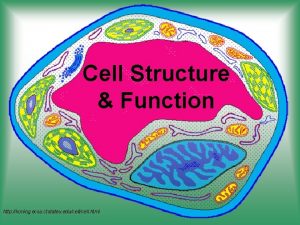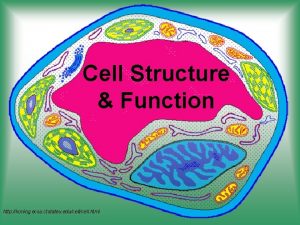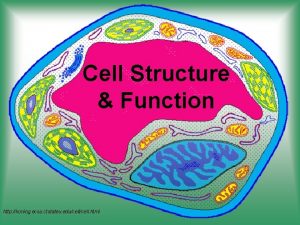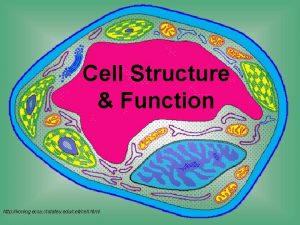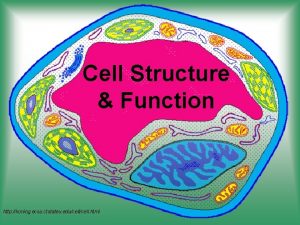UNIT 2 CELLS Cell Structure Function http koning











![Prokaryote/Eukaryote Comparison [see resources] Prokaryote/Eukaryote Comparison [see resources]](https://slidetodoc.com/presentation_image/362a70bf31d9a397582b49fdebf12972/image-12.jpg)































![Cell Organelle Songs [select one or two] o. The Cell Song o. Cells, Cells Cell Organelle Songs [select one or two] o. The Cell Song o. Cells, Cells](https://slidetodoc.com/presentation_image/362a70bf31d9a397582b49fdebf12972/image-44.jpg)


- Slides: 46

UNIT- 2 CELLS

Cell Structure & Function http: //koning. ecsu. ctstateu. edu/cell. html

Essential Question: What is the relationship between the structure and function of cell organelles? Standard: S 7 L 2 b. Relate cell structures (cell membrane, nucleus, cytoplasm, chloroplasts, mitochondria) to basic cell functions.

Some Random Cell Facts • The average human being is composed of around 100 Trillion individual cells!!! • It would take as many as 50 cells to cover the area of a dot on the letter “i” WOW!!!

Discovery of Cells • https: //www. youtube. com/watch? v=FUq. ORLDDw. VM • 1665 - English Scientist, Robert Hooke, discovered cells while looking at a thin slice of cork. • He described the cells as tiny boxes or a honeycomb • He thought that cells only existed in plants and fungi

Anton van Leuwenhoek • 1673 - Used a handmade microscope to observe pond scum & discovered single-celled organisms • He called them “animalcules” • He also observed blood cells from fish, birds, frogs, dogs, and humans • Therefore, it was known that cells are found in animals as well as plants

150 -200 Year Gap? ? ? • Between the Hooke/Leuwenhoek discoveries and the mid 19 th century, very little cell advancements were made. • This is probably due to the widely accepted, traditional belief in Spontaneous Generation. • Examples: -Mice from dirty clothes/corn husks -Maggots from rotting meat

19 th Century Advancement n Much doubt existed around Spontaneous Generation n Conclusively disproved by Louis Pasteur: Ummm, I don’t think so!!! = + ?

Development of Cell Theory • https: //www. youtube. com/watch? v=dsc. Y_2 QQb. KU&inde x=16&list=PLMm 2 qcd. Bsrtqc 4 O 24 Bmxr. DHTDc 0 FSl_Xb • 1838 - German Botanist, Matthias Schleiden, concluded that all plant parts are made of cells • 1839 - German physiologist, Theodor Schwann, who was a close friend of Schleiden, stated that all animal tissues are composed of cells.

Development of Cell Theory • 1858 - Rudolf Virchow, German physician, after extensive study of cellular pathology, concluded that cells must arise from preexisting cells.

The Cell Theory 1. All living things are composed of one or more cells. 2. Cells are organisms’ basic units of structure and function. 3. Cells come only from existing cells.
![ProkaryoteEukaryote Comparison see resources Prokaryote/Eukaryote Comparison [see resources]](https://slidetodoc.com/presentation_image/362a70bf31d9a397582b49fdebf12972/image-12.jpg)
Prokaryote/Eukaryote Comparison [see resources]

Two Types of Cells • Scientists separate cells into two broad categories based on the location of the genetic material cells need to reproduce and function. • Prokaryotic Cell – 1. there is no separate compartment for the genetic material (no nucleus); • 2. lack of membrane bound internal organelles • 3 they are always unicellular ex. bacteria • Eukaryotic Cell – the genetic material is in a structure enclosed by its own membrane (nucleus)

Prokaryotic Cells • 1. genetic material or structures are not surrounded by membranes • 2. no or Few internal structures( organelles) • 3. Are always Onecelled organisms such as Bacteria Genetic Material

Prokaryotes Eubacteria Archaebacteria

Eukaryotic Cells Genetic Material • Genetic material is in a structure enclosed by its own membrane ( have nucleus) • Contain organelles surrounded by membranes • Ex. -Most living organisms

Fungus like Fungus Eukaryotes mushroom Protists Algae nerve cells Paramecium Plants kitten Animals human

PROKARYOTIC CELL VS. EUKARYOTIC CELL PROKARYOTIC CELL • 1. genetic material or structures are not surrounded by membranes 2. no or Few internal structures( organelles) 3. Are always One-celled organisms such as Bacteria EUKARYOTIC CELL • 1. Genetic material is in a structure enclosed by its own membrane ( have nucleus) • 2. Contain organelles surrounded bymembranes • 3. Ex. -Most living organisms

Eukaryote/Prokaryote Comparison 1. Name as many differences as you can between the two cells. 2. Of the two cells, which one do you think can perform more activities? Explain your answer. 3. Which of the two cells do you think was the first to appear on Earth? Explain your answer. 4. If the prefix eu- means true and prefix pro- means prior to, which cell is a prokaryote and which is a eukaryote?

Two Types of Eukaryotic Cells Plant Cells and Animal Cells

In most diagrams of plant and animal cells, you will notice many organelles (parts). For our lesson on cell organelles, we will focus on just a few organelles.

Eukaryotic Cells: Plant & Animal Plant and Animal cells both contain similar organelles (parts), but there a few differences.

Use the Plant and Animal Cell Diagrams to Label Organelles

Plant Cell 5. Vacuole 7. Cytoplasm 6. Chloroplasts 4. Cell Wall 3. Cell Membrane 8. Mitochondrion (pl. Mitochondria) 9. Ribosomes (black dots) 1. Nucleus 2. Chromosomes (genetic material) 12. Rough ER 10. Lysosome 11. Golgi Body

Cell diagrams often vary. Let’s look at another diagram of a Plant Cell for similarities.

With a seat partner, use your labeled Plant Cell Diagram to identify the organelles of this Plant Cell. Write your answers down. 1 2 3 4 5 6

With a seat partner, use your labeled Plant Cell Diagram to identify the organelles of this Plant Cell. Be ready to explain how you know. What did we miss? Cell Wall 1 Chloroplast 2 Cytoplasm 3 Nucleus 4 Mitochondria 5 Cell Membrane 6

Animal Cell Before we begin to label Animal Cell Organelles, what are some of the similarities with a Plant Cell?

Animal Cell With a PENCIL, write in your guess of the animal cell organelle name.

Animal Cell 3. Vacuole 2. Nucleus 4. Cytoplasm 5. Ribosomes 1. Cell Membrane 11. Lysosomes 10. Rough ER 9. Smooth ER 6. Golgi Body 8. Chromosomes 7. Mitochondrion

View Inside a Cell http: //learn. genetics. utah. edu/ content/cells/insideacell/

Organelles of a Cell • Cell Membrane – 1. semi-permeable membrane that forms the boundary of the cell and 2. controls what comes in and goes out of the cell. • Nucleus- 1. Control Center of the Cell; controls the functions within the cell and 2. contains the genetic material. • Chromosomes – Physical structures in a nucleus that contain the cell’s genetic material which provides instructions for the cell’s functions (more to come in next unit).

Organelles of a Cell • Cell Wall – Provides additional structure and support for cells( in plant cells). • Chloroplast – found in cells that contain chlorophyll (plants)and uses light energy to make food for the cell. • Cytoplasm – Gel-like substance that move nutrients through in the cell and also acts as a shock absorber. • Mitochondria (singular Mitochondrion) Breaks down food material and releases energy into the cell.

Organelles of a Cell • Vacuole- stores food, water and waste products. Is much larger in plant cells. • Ribosomes- produces proteins in the cell. • Rough Endoplasmic Reticulum (ER)transports molecules throughout the cell. The surface contains ribosomes

Organelles of a Cell • Smooth ER- transports molecules throughout (within )the cell. • Golgi Body- receives, processes, packages and ships molecules around and out of the cell. • Lysosomes- breaks down food particles, invading objects, or worn out cell parts. they are also called suicidal bags of the cells

PLANT CELLS VS. ANIMAL CELL PLANT CELL ANIMAL CELL 1. HAS CELL WALL 2. HAS LARGE CENTRAL VACCOULE TO STORE LARGE AMOUNTS OF WATER 3. HAS CHLOROPLAST TO DO PHOTOSYNTHESIS 1. NO CELL WALL 2. NO CENTRAL VACCOULE BUT HAS MANY SMALL FOOD VACOULES 3. HAS NO CHLOROPLAST

Brain Pop Video on Cell Structures and Function http: //glencoe. mheducation. com/sites/dl/fr ee/0078778425/164155/00035804. html

Possible Activities for Reviewing Cell Organelles: • Onion and Cheek Cell Lab or view microscope slides of cells • Cell Organelle Matching Activities • Cell Diagram Variation Worksheet • QR Codes Cell Organelle Review • Give students an unlabeled cell diagram and have them work in pairs to quiz each other • Cell Organelle Slipcover - Put unlabeled cell diagrams in clear slipcovers. Give each student a slipcover, vis-à-vis or expo marker, and paper towel (a sock is also good and cheaper). Call out cell organelles and have students circle the organelle and hold up their slipcover when instructed. • Break Up Letter • Tiered Activity

Cell Analogies are often used to help understand the functions of cell organelles.

Use the Cell Analogy Handout to Record your Answers.

What type of Cell is this? How do you know?

Cell Organelle Analogy: Factory Chromosomes Nucleus Mitochondria Chloroplast Cell Wall Cytoplasm Cell Membrane

Cell Organelle Analogy: City Matching Cards Activity After completing the activity, do Part II of the Cell Analogies handout.
![Cell Organelle Songs select one or two o The Cell Song o Cells Cells Cell Organelle Songs [select one or two] o. The Cell Song o. Cells, Cells](https://slidetodoc.com/presentation_image/362a70bf31d9a397582b49fdebf12972/image-44.jpg)
Cell Organelle Songs [select one or two] o. The Cell Song o. Cells, Cells Parts of the Cell Rap ohttp: //youtu. be/BTic. XXxz. QA 4 o. Cell Song to the tune of “The Lion Sleeps Tonight”

Activities to Review Cell Organelles and Functions • Cell Organelle Tic-Tac-Toe • Cell Organelle STUDY [BINGO]

Cell Organelle Summarizer
 Unit 5 cell structure and function answer key
Unit 5 cell structure and function answer key Het schaakbord van koning shirham
Het schaakbord van koning shirham Cfidf
Cfidf Teef manlik
Teef manlik Giovanna koning
Giovanna koning Het jaar van de olifant islam
Het jaar van de olifant islam Poolse koning 1704
Poolse koning 1704 Arjan koning
Arjan koning De rechtmatige koning van alba longa heet
De rechtmatige koning van alba longa heet Verkleinwoorde for meisie
Verkleinwoorde for meisie Koning en koningin
Koning en koningin Rence damming
Rence damming Hans peter de koning
Hans peter de koning Groups of cells with a common structure and function.
Groups of cells with a common structure and function. Groups of cells that are similar in structure and function
Groups of cells that are similar in structure and function Tissues are groups of similar cells working together to:
Tissues are groups of similar cells working together to: What is the function of a cell
What is the function of a cell Sphenoid paranasal sinus
Sphenoid paranasal sinus Principal cells vs intercalated cells
Principal cells vs intercalated cells Parafollicular cells vs follicular cells
Parafollicular cells vs follicular cells Gametes vs somatic cells
Gametes vs somatic cells Why dna is more stable than rna
Why dna is more stable than rna Red blood cells and white blood cells difference
Red blood cells and white blood cells difference Eucariote
Eucariote Venn diagram animal and plant cells
Venn diagram animal and plant cells Prokaryotes vs eukaryotes venn diagram
Prokaryotes vs eukaryotes venn diagram Why did robert hooke name cells “cells”?
Why did robert hooke name cells “cells”? Masses of cells form and steal nutrients from healthy cells
Masses of cells form and steal nutrients from healthy cells Pseudostratified vs simple columnar
Pseudostratified vs simple columnar Cuál es la diferencia entre la célula animal y vegetal
Cuál es la diferencia entre la célula animal y vegetal Prokaryotic cells
Prokaryotic cells Nondisjunction in meiosis
Nondisjunction in meiosis Cells and life lesson 1 answer key
Cells and life lesson 1 answer key Bacterial cell structure and function
Bacterial cell structure and function Lesson 3 cell structure and function answer key
Lesson 3 cell structure and function answer key Cell structures cell organelle graphic organizer
Cell structures cell organelle graphic organizer Function of vacuole in plant cell
Function of vacuole in plant cell Lesson 3 cell structure and function answer key
Lesson 3 cell structure and function answer key Biology chapter 7 cell structure and function
Biology chapter 7 cell structure and function Chapter 7 cell structure and function section review 7-2
Chapter 7 cell structure and function section review 7-2 Organelle
Organelle Chapter 5 cell structure and function
Chapter 5 cell structure and function Cell structure and function
Cell structure and function Category 1 cell structure and function
Category 1 cell structure and function Category 1 cell structure and function
Category 1 cell structure and function Category 1 cell structure and function
Category 1 cell structure and function Diamond zinc blende structure
Diamond zinc blende structure
